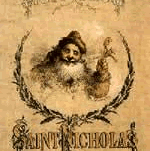Santa and the Airship
Listen to the Recess! Clip
| Author | Rita Smith |
| Air Date | 12/5/2003 |

Santa and the Airship Transcript
For hundreds of years, the fastest most efficient way to get around in the winter was the sleigh and for hundreds of years Santa has depended on a sleigh to get toys to all the good boys and girls on Christmas Eve. You might wonder why, with all the speedier forms of transportation now available, Santa still drags the sleigh out of the igloo on Christmas Eve rather than using an SUV, bullet train or an SST. Well, Santa tried new technology once, with disastrous results and he learned his lesson for all time. The unfortunate incident happened in 1902 and was reported in St. Nicholas Magazine for Boys and Girls.
One day in early November, Santa Claus was sitting in his living room per- using that morning’s edition of the Weekly Iceberg News when his eye was attracted by an ad for a flying machine, a dirigible airship with a gasoline powered engine, invented by a Brazilian named Santos-Dumont. “Why, bless me!” Santa thought. “I’ll bet that’s a cousin of mine. The name’s misspelled, (Santos instead of Santa) but the papers seldom get names right anyway.” That very day Santa Claus sent off for one of the airships and after a month of waiting, it arrived at 20 North Pole Place and he began taking it on practice trips over the North Pole.
Santa spent all day Christmas Eve, with the help of his elves, gathering up the toys from his workshop and warehouse and loading them into his new airship, ignoring his heartsick reindeer who pawed the snow in vain. When the airship was full, he took the controls, lifted off the ground and headed south. For a while everything worked smoothly, just like the practice flights, but suddenly, over London, and for no apparent reason, the ship pitched forward, then backward. It veered from side to side, bucked, swooped and wobbled totally out of control. The toys spilled over the basket and fell through the sky, and into the chimneys of children who were bad fell many toys and gifts they didn’t deserve. And nothing fell into chimneys of children who were good, except maybe some debris from the airship. The next day, the bad children were boastful and the good children were puzzled and sad and Santa Claus was back at home, feeling very very sorry that good children were so deceived.
That very day Santa went into his empty workshop and got a piece of board and painted a large sign which he placed in front of his workshop: For Sale: One large new aero-plane. It quickly sold and Santa learned his lesson and ever since has packed his sleigh and delivered his toys the old fashioned way.
Source:
Sabin, Edwin L. “A Christmas Mistake,” in St. Nicholas Magazine for Children, December 1902. Vol. 30, No.2. New York: The Century Company, p. 99.